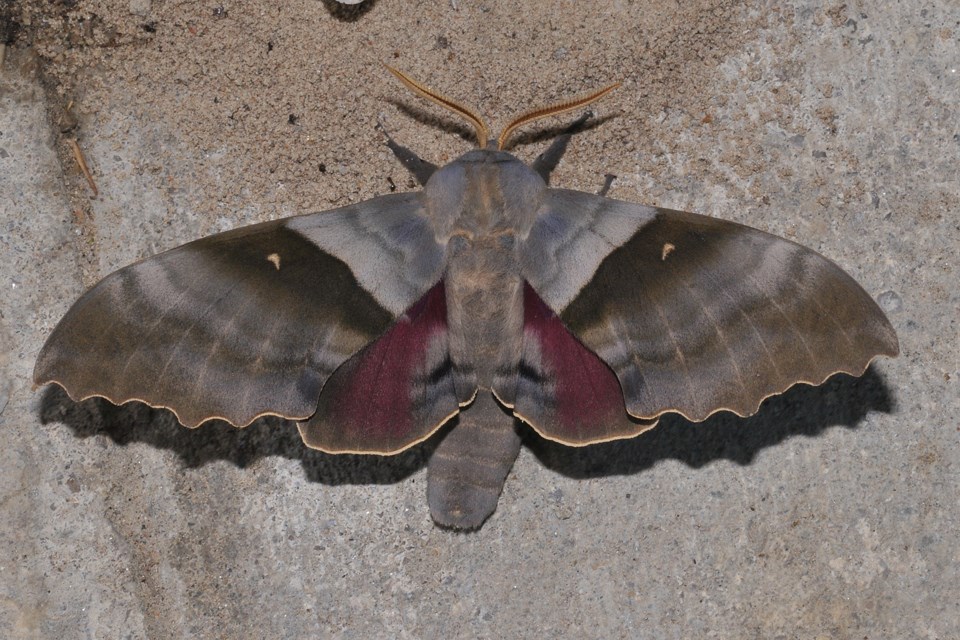Breakfast is usually shared with my grandson, 11-year-old Toby, who wanders over from the farmhouse just across the yard.
For many years, we have spent these morning visits discussing (in minute detail) various Minecraft characters, new releases of Lego kits, or have challenged each other to create a drawing of some bizarre idea like “what would the planet Cactoid look like if all the creatures had to look like a cactus?”
Recently, when Toby drops into the breakfast chair, he begins the conversation with “Saw a black-dotted glyph, a green pug and three small-eyed sphinx. And Mom found a single-dotted wave.”
Say what? I now realize that these characters are not from some video game empire but rather from a portion of the animal kingdom known as moths.
A couple months ago they noticed, by the dawn’s early light, a collection of moths attached to the white stucco wall surrounding a porch light. What had caught their attention were a couple of bat-sized insects with spectacular colours… a polyphemus moth and a cecropia moth.
These moths are truly impressive in both size and colour and simply demand that the observer grab an identification guide, which is exactly what Toby and Erin did… by raiding Grandpa’s book shelf.
To really top it off, a few days later a luna moth appeared thus providing a suite of silk moths to “ohh-and-aww” over. And then came the sphinx moths, also large and bedecked in amazing patterns and colour combinations.
Due to all this close scrutiny of the porch wall, there were also discovered an array of small moths, the ones usually overlooked and dismissed as “just moths.”
With the help of the Peterson Field Guide to Moths of Northeastern North America, by David Beadle and Seabrook Leckie, the dazzling world of mothing opened up for these new mothers. (No, not mothers, ‘moth-ers’; people who study moths… like birders, only looking at scaly wings rather than feathered wings.)
It is estimated that in North America there are 11,000 species of moths, many still unknown as to ranges, which plants the caterpillars eat, or who eats the moths.
Understanding the ecology of moths is a somewhat new field of study, yet with the marvel of the internet the sharing of observations and assisting with identifications has created a new wave of naturalists intent on finding, identifying and listing the neighbourhood’s night flyers.
Mind you, there exists a couple of daytime moths, so not all is lost to those of us who relish our sleep time. The Virginia ctenuchia moth (pronounced “ten-OO-chee-ah”) is commonly found flitting about milkweed flowers and of course, this year anyway, is the super-abundant gypsy moth.
But for good mothing a tolerance for a late night/early morning bedtime is required.
Not content with just sitting on the porch under the incandescent bulb, waiting to see what might drop by, mothers (did you say it right this time?) have employed light traps consisting of hung white cotton sheets illuminated with black-light bulbs or mercury vapour lamps.
There is still question as to why moths are attracted to these night lights, which just underscores the lack of knowledge we have about moths.
Another trick to get the winged beasties to come close to hand is to mix together a concoction of a really ripe banana, brown sugar and a dollop of molasses and smear this on a tree trunk. There are many moths that are pollinators and this nectar-like goo will attract them, well, like moths to a flame.
With so many species showing up in our valley, Toby felt we should list them, similar to how we track the birds that visit our bird feeder. And here is where our collective home schooling experiences kicked in to play.
To make a chart we needed to learn how Excel spreadsheets can be set up on the computer: rows and columns are labelled and highlighted; spelling corrected; new names inserted.
To identify the critters an awareness of how the field guide is laid out, with family groupings illustrated and sorted by common characteristics like wing shape and colour patterns. Observation skills are honed by determining if the wing edge is scalloped or smooth.
Latin language is introduced both within the scientific name and often the common name. There are some real tongue-twisters to master if you want to sound like you know more than you actually know. With these names comes an introduction to Greek mythology, as why would a moth be called Io, Polyphemus or Promethea?
Range maps bring in the study of geography, providing an understanding the Great Lakes basin and why associated biomes support certain species of plants and moths while a neighbouring habitat type may not.
Terms like Carolinian, coastal, deciduous and conifer forest cover, and sometimes the differential nuances between urban versus agricultural.
Food plants need to be identified, as caterpillars of each moth species tend to be fussy about their diet, so knowing if you have tulip-trees in the neighbourhood, or not, may help determine the identification of a moth, just as milkweeds are so linked with monarch butterflies.
A side note is that when I visit a Facebook page dedicated to moth identification, there is my daughter’s name posted as someone confirming or correcting another person’s post of their moth discovery. So now she is both a mother and a mother. (Get it? Mother and a moth-er?)
So what’s it going to be today? A white eulithis or a false crocus geometer? A great ash sphinx or a reversed haploa (which would be neat as they are usually Carolinian in their home range).
Time to fill the cereal bowls and wait for the latest front wall report.

.jpg;w=120;h=80;mode=crop)

